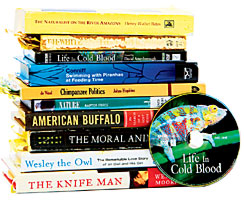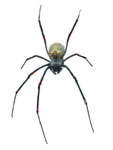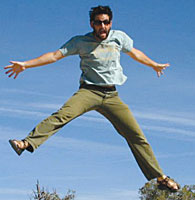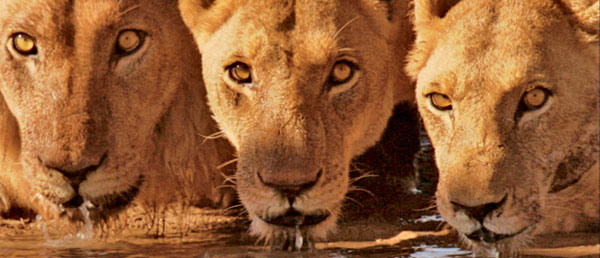sierraclub.org - sierra magazine - may/june 2009 - mixed media


Mixed Media
Critter Encounters | Earth Beat: Small-Town Voices | Spider Man
Exploring our fascination with the animal kingdom
 Years ago, a magazine sent me to Jersey in the Channel Islands to interview Gerald Durrell, the zookeeper and pioneer in the captive breeding of endangered species. Durrell wrote one of my favorite books, My Family and Other Animals (Viking, 1957), the classic account of his obsession with wildlife while growing up in an eccentric British family on the Mediterranean island of Corfu.
Years ago, a magazine sent me to Jersey in the Channel Islands to interview Gerald Durrell, the zookeeper and pioneer in the captive breeding of endangered species. Durrell wrote one of my favorite books, My Family and Other Animals (Viking, 1957), the classic account of his obsession with wildlife while growing up in an eccentric British family on the Mediterranean island of Corfu.
The interview started at 10 a.m., with tumblers of whiskey the size of swimming pools and Durrell waxing romantic on the possibilities of being reincarnated as a fur seal: "One would swim a thousand miles to marry a female fur seal! They look as if they've been made out of molten gold." In person and in print, Durrell reminded me that it's possible to write about the natural world and still have fun, and also that the best fun comes from exploring the often quirky connection between people and animals.
In many of my favorite books, the boundaries slip away, as they should, and readers will find themselves cast loose in the animal world. The lines of Maurice Sendak's Where the Wild Things Are (Harper and Row, 1963) still sometimes run through my head as I fall asleep: "That very night in Max's room a forest grew and grew and grew until his ceiling hung with vines and the walls became the world all around." A similar thrill of crossing over animates T. H. White's The Sword in the Stone (1938), in which the magician Merlyn turns a boy named Wart into a fish and then into a bird to give him the wisdom he will need to become King Arthur.
White also introduces modern readers to the fanciful creatures that delighted the medieval imagination (and mine) in The Book of Beasts (Putnam, 1954), his translation of a 12th-century bestiary. The bisonlike bonnacon, for instance, had the magical power to escape predators with a three-acre fart that set trees on fire. In The Wind in the Willows, first published in 1908, Kenneth Grahame takes readers into a fanciful animal world, and a new annotated edition by Grahame scholar Annie Gauger (W. W. Norton and Company, 2009) adds rich new depth to this classic.
Of course, reality is good too, especially when dished out by David Attenborough, in documentaries from Life on Earth (BBC, 1979) through the recent Life in Cold Blood (BBC, 2008). While other natural history presenters rely on the trick of getting close only to show how animals react to their macho intrusions, Attenborough's close-ups reveal the quirky ways animals behave on their own--for instance, a python sticking its windpipe out its mouth so it can continue to breathe while swallowing a deer.Seeing the world through animal eyes is also the driving idea behind the PBS Nature documentary Raptor Force (Galatee Films, 2007), which takes a ride with a peregrine falcon on its 200-mile-an-hour dive.
Claude Nuridsany and Marie Perennou's film Microcosmos (Miramax, 1996) quietly opens up a world where the slow, sunlit emergence of a mosquito on the surface of a pond can seem like the birth of a god (at least until it flits away with that infernal whine). I suspect the French directors drew inspiration from their countryman Jean-Henri Fabre, the 19th-century entomologist. In The Insect World of J. Henri Fabre (1949), Fabre comments on "the abysmal stupidity of insects as a class" while taking contagious delight in the details of their strange behaviors.
Lately I have been reading books about early biological discoveries, and The Naturalist on the River Amazons (1873) by Henry Walter Bates is a favorite. Unlike other 19th-century explorers, who often make prickly, priggish travel companions, Bates is a delight, with a broad, easygoing curiosity and an appreciative eye not just for South American wildlife but also for local people and customs.
A book about John Hunter, the 18th-century "father of modern surgery," might seem like an odd choice in a nature column. Hunter's dissections of cadavers from the guillotine and the grave made him a likely model for Dr. Jekyll (and perhaps Mr. Hyde). But the menagerie at his house outside London, including a pair of leopards, also made him the inspiration for Dr. Dolittle. In The Knife Man (Broadway, 2005), Wendy Moore shows how Hunter helped pioneer the scientific description of new species.
For the next couple of selections, queue up chimpanzee-themed "Another Postcard" by the band Barenaked Ladies. Frans de Waal's Chimpanzee Politics: Power and Sex Among Apes (Harper and Row, 1982) uses the close study of captive chimpanzee groups to demonstrate that our Machiavellian politics are rooted in primate behavior. Robert Wright's Moral Animal: Why We Are the Way We Are (Vintage, 1995) expands that lesson into an excellent introduction to evolutionary psychology.
Among current books, I am enjoying Wesley the Owl: The Remarkable Love Story of an Owl and His Girl (Free Press, 2008) by Stacey O'Brien. I'd always thought owls were laid-back, compared with, say, hummingbirds, but O'Brien tells us that a barn owl dad during nesting season may need to bring home 37 mice a night to keep his brood happy. A different kind of hunt, the author's pursuit of a buffalo in the Alaska wilderness, provides the narrative framework for Steven Rinella's American Buffalo: In Search of a Lost Icon (Spiegel and Grau, 2008). Rinella brings readers closer to his subject than some may care to get, dwelling, for instance, on the massive buffalo trachea (an adaptation for preheating air in frigid climates).
For a change of mood, finally, I was going to recommend a tranquility blog featuring peaceful scenes from nature. But here is a better idea: Shut off your computer or TV, go outside, and sit under a tree. Try to get inside the minds of the birds and spiders and ants around you. And now and then, close your eyes and dream. --Richard Conniff
Spider Man
 I was watching a spider spin its astonishing construction between my desk lamp and telephone, and I suddenly wanted to become a spider, at least for a little while. I picked up the phone (a cataclysm for the spider) and found a climbing instructor named Stefan Caporale, who agreed to help me build my own orb web between two climbing walls at the YMCA in Worcester, Massachusetts. Caporale fitted me out with a climbing harness and Jumar ascenders. With a slingful of the metal clips called carabiners over one shoulder and a rope bag in lieu of a silk gland over the other, I felt like Charlotte's Web meets Rambo.
I was watching a spider spin its astonishing construction between my desk lamp and telephone, and I suddenly wanted to become a spider, at least for a little while. I picked up the phone (a cataclysm for the spider) and found a climbing instructor named Stefan Caporale, who agreed to help me build my own orb web between two climbing walls at the YMCA in Worcester, Massachusetts. Caporale fitted me out with a climbing harness and Jumar ascenders. With a slingful of the metal clips called carabiners over one shoulder and a rope bag in lieu of a silk gland over the other, I felt like Charlotte's Web meets Rambo.
I was, of course, going to have to cheat, starting from the moment I climbed one wall, tied my first line, and looked across 15 feet of open space to the point where I'd be anchoring the opposite end. A spider bridges this span the same way it makes a parachute, by lifting its hind end and paying a length of silk out onto the breeze. This wasn't going to work for me.
--from Swimming With Piranhas at Feeding Time: My Life Doing Dumb Stuff With Animals, by Richard Conniff (Norton, 2009)
Richard Conniff explores the curious behavior of humans and nonhumans with equal zeal. His books include The Ape in the Corner Office: Understanding the Workplace Beast in All of Us (Crown, 2005) and Every Creeping Thing: True Tales of Faintly Repulsive Wildlife (Holt, 1998).
Earth Beat | Small-Town Voices
 The plucky staff of High Country News pound out their 25,000-circulation newsmagazine from the tiny town of Paonia, Colorado, but their take on Western environmental issues is heard nationwide. The biweekly is an indispensable source for big-city environmentalists. Sierra talked with editor in chief Jonathan Thompson about how a small paper makes big waves.
The plucky staff of High Country News pound out their 25,000-circulation newsmagazine from the tiny town of Paonia, Colorado, but their take on Western environmental issues is heard nationwide. The biweekly is an indispensable source for big-city environmentalists. Sierra talked with editor in chief Jonathan Thompson about how a small paper makes big waves.
How did you end up covering Western environment issues?
I grew up in Durango, not far from here. My father was a journalist and an advocate for wilderness areas. So I was born into an interest in the West. By extension, that meant I was interested in the environment because so much of who we are in this region is tied to the land.
What are the advantages of a regional publication?
We look at the West as a place in and of itself, which a lot of publications don't do. The hard thing is that our region is huge: from the Pacific coast to the Great Plains.
How do you balance urban and rural coverage?
We tend toward the rural. We ask, what about an urban issue makes it a High Country News story? The story of Los Angeles water use is our story because L.A. draws on the Colorado River.
Are you happy when major media crib your stories?
It's flattering and frustrating. That's what we're here for: to cover issues in the West that other people didn't know existed. It forces us to probe deeper. We follow these issues every day, so we can add more context.
How is the West, and your coverage, changing?
We cover exurban sprawl and population growth. Places like Phoenix, Denver, and Las Vegas are growing like crazy. We end up paying more attention to national politics than we once did, since we're now a player in that game. It's incredible how much time candidates spend in small Western towns. Both Barack Obama and Sarah Palin came to Grand Junction, a town of about 50,000, and had rousing crowds.
Do your green and rural readerships clash?
We've always been pro-consensus-building, and believe that the ranchers have a say. We don't advocate stopping all grazing on public land, and that's gotten us into trouble with some environmentalists. On the other hand, when we saw the Bush administration trampling the West, we called them out, and that got us into trouble with some of our more conservative readers.
In a rural area, you see your adversaries every day.
When I wrote for a newspaper in Silverton, which has a winter population of 400, I wasn't shy about the fact that I didn't like snowmobiles running rampant on public land, and I wrote about it. But you've got to have a certain amount of diplomacy. We're in the same boat at High Country News. Our readers are a diverse group. We need to communicate to all ranges of that community.
High Country News has been accused of buying into a "cowboy mythology" of the West. Is that fair?
Less so than in the past. We are in a ranching and farming community, and we see that sometimes it can help to keep the ranchers on the land.
How does a small publication stay alive these days?
We're a nonprofit that relies heavily on small donations. Those people are still going to send something.
You upgraded your Web site (hcn.org) recently.
As recently as three years ago, our Web site was essentially dead. Every two weeks we'd throw our print content on the Web, and for two weeks nothing happened. Since then we've added blogs and Web-only content, and it's much more vital.
Will your coverage change under the Obama administration?
We won't bash everything that the government is doing. It was pretty clear that the Bush administration was putting gas and oil at the top of the list of what gives public lands their value. Every time we turned around, they were doing something new to remove protections from public land. We were reacting to that.
There are problems in the lands agencies that go deeper than the Bush administration, and it will take a lot of political will to fix them. We'll still be bashing the agencies because they'll still be doing things that we feel aren't right. At the same time, we've seen Ken Salazar making big changes as secretary of Interior. He pulled a bunch of gas leases in Utah and went into the Minerals Management Service and said, "We're fixing this place." Our approach will be a little bit different because of that.
What Western issue doesn't get enough attention?
Climate change and its effect on water.
What's your environmental vice?
I like long showers. That will resonate. Our readers have told us that water is their number-one concern.
—interview by Reed McManus
Bambi's Back

Disney Studios hasn't made a nature documentary in nearly 50 years, but the wild success of 2005's March of the Penguins convinced it to wade, flap, and stampede back into the field. In April, Disneynature released Earth, the first of seven feature-length films. Fans of the gripping BBC-Discovery Channel television series Planet Earth will recognize some of the footage in this big-screen spectacle; both were created by British producer-director Alastair Fothergill.
Photos, from top: Robert A. Lisak, Lydia Thompson, BBC Worldwide Ltd.; used with permission